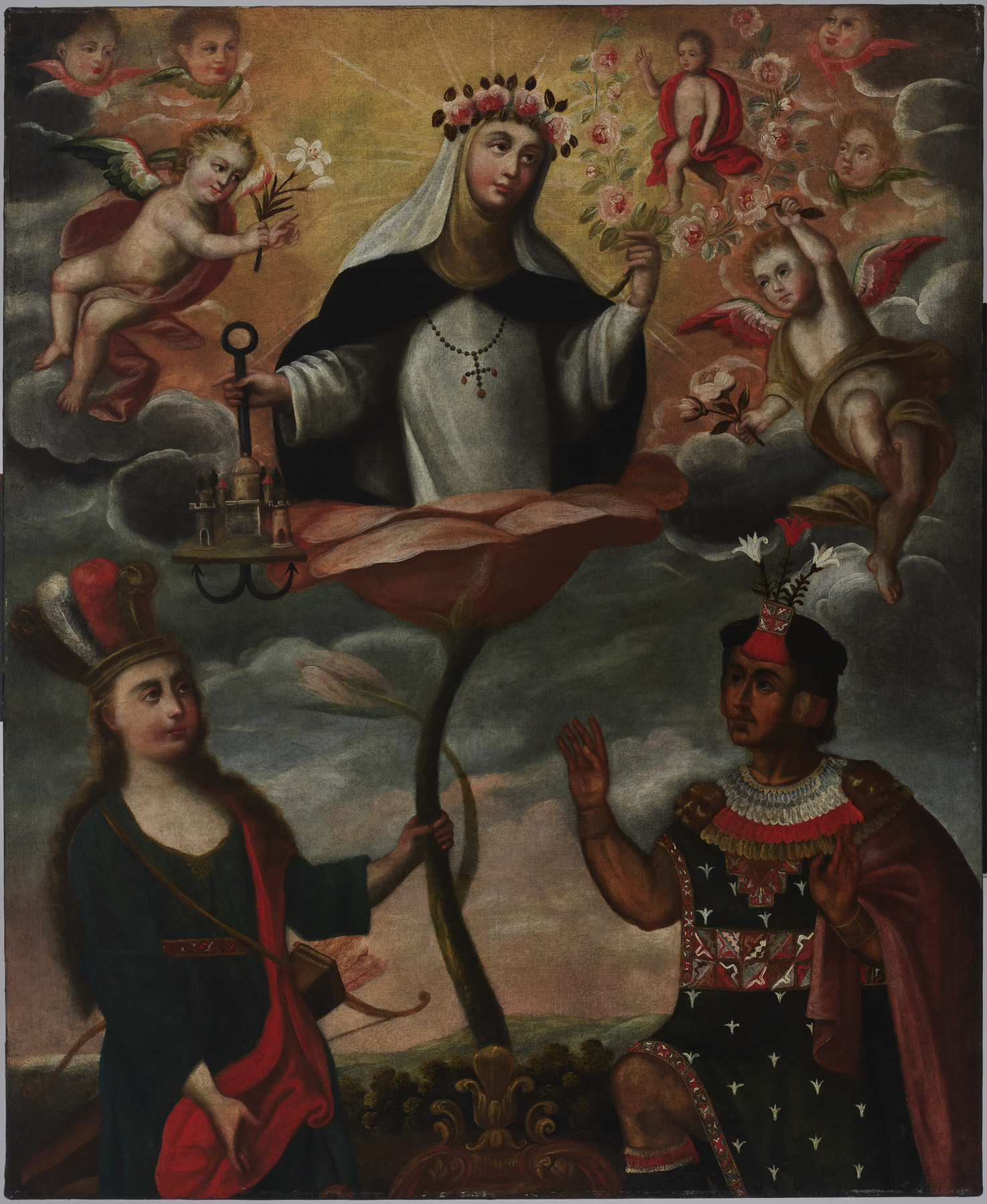An Allegory of Saint Rose of Lima
(Ancient Americas )
This is an allegorical painting of Saint Rose of Lima (1586-1617), the first American-born saint, flanked by two adult figures below, and by the Infant Jesus and flying angels and seraphim above. The work draws very directly on the engraved frontispiece of a 1511 collection of sonnets on St. Rose’s life by the Spanish writer Luis Antonio de Oviedo y Herrera. In that engraving, the saint, as in this painting, appears to sprout from a rose, and holds a halo of roses in one hand in which appears the baby Jesus. Her other hand holds an anchor, with the cathedral of Lima, Peru balanced on its tines, and the word “Lima” written below. (An anchor was the symbol of the port city of Lima, as the "anchor" of the colonial regime in Peru.) St. Rose is flanked below, as in the painting, by two figures. At the viewer’s left is an allegorical figure of America, recognizable by her feathered headdress and a bow and quiver of arrows. At the right in the print is the author, with the order of Santiago visible on his sleeve. The rose sprouts from a cartouche at the bottom, containing three crowns, and below, a banner with the words “St. Rose of Lima, Native of Lima and Patroness of Peru.”
In the painting, several changes are evident. The figure of America is clad in a blue dress, not nude as in the print. More importantly, the writer Oviedo y Herrera has been replaced by the figure of a stylized Inca king. He is recognizable as an indigenous man instantly, because of his darker skin tone and the Inca-style tunic he wears, with square patterns, known as tocapu, at the waist. In the painting, these are now generalized, but in pre-Columbian times specific patterns would have been important in signaling ethnic identity.
In this painting, the Inca has been Europeanized by the addition of golden pumas heads or other Roman gladiator-like motifs on his shoulders. To the initiated viewers of South American, he would have been instantly recognizable as a ruler because of the mascaypacha, a red fringe that hangs across his forehead, which was an integral part of the Inca king’s crown. In the painting, this is complemented as well by another tocapu above the diadem, and three flowers which sprout from this. These parallel the rose imagery of the saint, but a contemporary viewer would likely have been able to recognize these as the cantuta, royal flower of the Inca nobility since pre-Columbian times. By the mid 1700s, when this work was painted, kuracas, or indigenous nobles, still enjoyed great privilege in the Spanish colonial system, but the majority of indigenous peoples were employed in forced labor and mired in poverty. The imagery of pre-Columbian rulers was becoming more dominant, and may have played a role in the independence struggles that would begin soon afterwards. A 1781 uprising by the nobleman of Inca descent Túpac Amaru II invoked native heritage and its symbols. After that revolt, imagery of the Inca kings was prohibited in works for public view, and some such paintings were even destroyed, so this work is an extraordinary visual document of resistance in the face of colonial domination.
Provenance
Provenance (from the French provenir, 'to come from/forth') is the chronology of the ownership, custody, or location of a historical object. Learn more about provenance at the Walters.
Private collection, Argentina, prior to 1974. Sale, Guerrico & Williams auction house, Buenos Aires, prior to 1974; purchased by Maria Eloisa Berisso, Buenos Aires, prior to 1974; purchased by Federico Carlos Cia, Buenos Aires, 2014; purchased by Robert Simon Fine Art, New York, 2018; purchased by Walters Art Museum, 2019.
Geographies
Argentina
(Place of Origin)
Peru (Place of Origin)
Measurements
H: 64 × W: 50 9/16 in. (162.5 × 128.5 cm)
Credit Line
Museum purchase, 2019
Location in Museum
Not on view
Accession Number
In libraries, galleries, museums, and archives, an accession number is a unique identifier assigned to each object in the collection.
In libraries, galleries, museums, and archives, an accession number is a unique identifier assigned to each object in the collection.
37.2940


